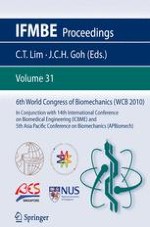2010 | OriginalPaper | Buchkapitel
The Role of Subchondral Tissues on Lubrication Properties of Natural Articular Cartilage
verfasst von : S. Yarimitsu, K. Nakashima, Y. Sawae, T. Murakami
Erschienen in: 6th World Congress of Biomechanics (WCB 2010). August 1-6, 2010 Singapore
Verlag: Springer Berlin Heidelberg
Aktivieren Sie unsere intelligente Suche, um passende Fachinhalte oder Patente zu finden.
Wählen Sie Textabschnitte aus um mit Künstlicher Intelligenz passenden Patente zu finden. powered by
Markieren Sie Textabschnitte, um KI-gestützt weitere passende Inhalte zu finden. powered by
Excellent lubrication properties of natural synovial joints are considered to be due to the adaptive multimode lubrication mechanism, in which various lubrication mechanisms functioned synergistically and hierarchically. In those lubrication mechanisms, hydration lubrication by the proteoglycan gel layer at the superficial zone of articular cartilage and the biphasic lubrication mechanism by the biphasic nature of articular cartilage are influenced by the extent of hydration and behavior of internal fluid in osteochondral tissues. In recent studies, possibilities of transport of fluid between cartilage layer and underlying tissues were indicated. Therefore, the influences of subchondral tissues on lubricating properties of natural articular cartilage were examined.
Reciprocating friction test was conducted by using a sliding pair of cylindrical natural articular cartilage with various thickness of subchondral tissues and glass plate. Normal saline and saline solutions of albumin and
γ
-globulin were selected as test lubricants.
It was found that cartilage specimen with thick subchondral tissues showed lower friction and cartilage specimen with thin subchondral tissues showed higher friction when saline and saline solutions of albumin and
γ
-globulin were used as lubricants. The remaining of the surface gel layer of articular cartilage was observed after friction test by atomic force microscope. In addition, there was no difference in changes of contact area against loading time between cartilage specimens with or without subchondral tissues. Considering the possibilities of transport of fluid between cartilage layer and subchondral tissues, it is considered that fluid transfer between cartilage layer and subchondral tissues influences on the extent of hydration, the behavior of internal fluid in osteochondral tissues and the functionalities of surface gel hydration lubrication and biphasic lubrication mechanisms. These findings indicated that subchondral tissues have an important role on maintaining the excellent lubricating ability of articular cartilage.
